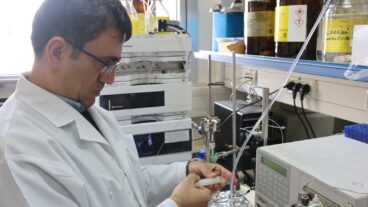Prof. Timor Baasov and his colleague Dr. Sima Yaron: Developing antibiotics against diseases is our specialty. In a development that marks a major step in fighting biological terror, researchers at the Technion Israel Institute of Technology have developed an antibiotic that destroys the anthrax bacteria as well as the toxins it secretes into the bloodstream of the infected body.
The study by Prof. Timor Baasov of Technion’s Faculty of Chemistry, together with Prof. Chi-Huey Wong of The Scripps Research Institute in California was reported in the international edition of the prestigious chemistry journal Angewandte Chemie. The article was chosen by the journal’s editors as ‘the hot paper’ of the edition.
Because the antibiotics attack not only the bacillus itself but also the toxic protein it releases into the bloodstream of the infected body, the journal termed this new development a ‘one-two punch’ – in terminology taken from boxing.
“We’ve been working on this project for about two years, but my lab has been dealing with the development of new antibiotics for more than 10 years,” Baasov told ISRAEL21c. “It’s our specialty, really, developing antibiotics against specific diseases. Last year, the study on our development of an antibiotic against cystic fibrosis was published.”
But Baasov explained that the focus in his lab shifted to solving the lethal problem of anthrax in the months after the September 11th attack on the United State in 2001. Developers of biological weapons have turned anthrax into a dangerous tool of war. The 1972 convention banning the spread of biological weapons prohibits the use of anthrax because its dispersion in the population can cause massive fatalities, a trait that has made it very attractive and desirable to terror organizations.
After September 11th, the US suffered anthrax attacks during which the bacillus was delivered through the mail. In 2001, five Americans died of anthrax inhalation.
“There’s been a very big push on the scientific community around the world to find a solution to the anthrax ever since. Its danger can be attributed to two problems: one, it’s asymptomatic – even once you’re infected with anthrax, there are not symptoms until the bacteria reaches the bloodstream,” said Baasov.
“Once it reaches the bloodstream, though, it’s too late – you only have a few hours to live.
And two, even if you manage to kill the bacteria with an existing antibiotic, the toxins that are released in the blood continue to work and cause death to the host.”
Anthrax, which generally affects animals and not humans, is known to be able to withstand dryness and high temperatures. It attacks the body through penetration of open wounds, the digestive system or the respiratory system. After penetrating the body, it begins to release an extremely toxic protein into the bloodstream, which paralyzes the victim’s immune system and causes death.
According to Baasov, the team’s testing in the lab, which was funded by the United States’ National Scientific Foundation, showed that the antibiotic also neutralizes the toxic protein, even if the bacillus already has released it into the bloodstream before it was neutralized.
Anthrax toxin comprises three proteins: protective antigen (PA), edema factor (EF), an adenylate cyclase that impairs phagocyte function, and lethal factor (LF), a protease deadly to macrophages. Because it acts like a conduit to permit entry of EF and LF into target cells, PA represents a key target for antitoxic strategies.
“Until two or three years ago, we didn’t know much about the toxins or their structure. Once we were able to ascertain which were the most dangerous toxins, we were able to design chemical compounds that could neutralize them.
Our antibiotic has a dual effect – it kills the anthrax bacteria but it also kills the toxin.
I believe the journal had a nice name for it – the one-two punch,” said Baasov, who emigrated to Israel from the former Soviet Union in 1974.
He said that the team is currently testing the compound on rodents and rabbits in order to develop their findings in preparation for applying them to human beings.
“I don’t think it will be possible to test this on people – infecting people with anthrax is dangerous and potentially lethal,” said Baasov.
“We’ve implemented all the design and preparation of the antibiotic in the lab here. But the testing of the compound was done at Professor Wong’s lab in California. Needless to say, it’s very dangerous to work with anthrax, and not every lab is authorized or equipped to conduct tests like that,” said Baasov.
He hopes that if the animal testing provides the same positive results as the findings they received in the lab, the antibiotic will be made available for real-time cases on animals and people.
In response to the breakthrough, Prof. Ehud Keinan, the dean of the Technion’s chemistry faculty, said this was a “revolutionary development with major implications in the war against terror.”












